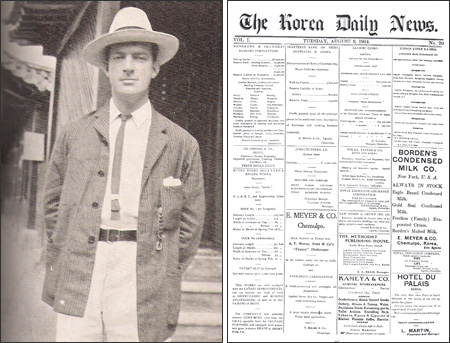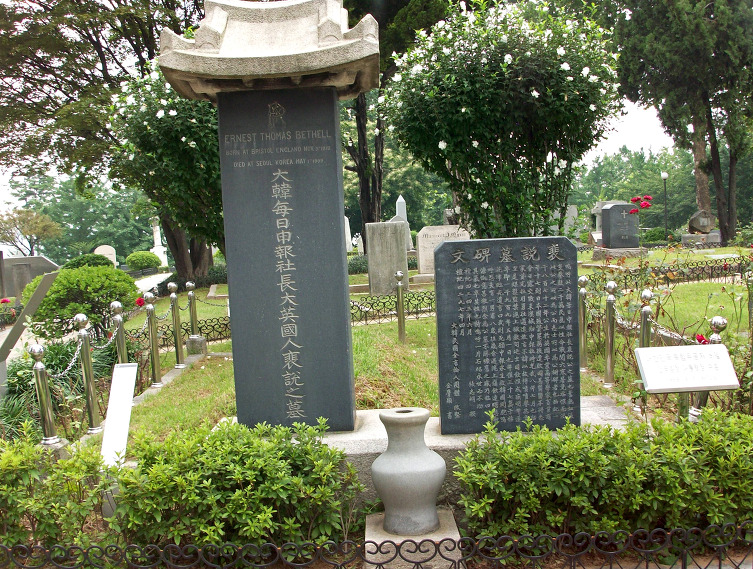Bethell, Hulbert, Gale and the Epic Stories of Two
Pagodas
The Wongak-sa Pagoda
Wongak-sa Pagoda is a twelve metre
high ten-storey marble pagoda in the center of Seoul, South
Korea. It was constructed in 1467 to form part of
Wongak-sa temple, that King Sejo had founded two years before on
the site of an older Goryeo-period temple, Heungbok-sa.
"Won'gak-gyeong" is the Korean name of a Buddhist sutra, 圓覺經 The Sutra of Perfect Enlightenment
or Complete Enlightenment which King Sejo had
found deeply meaningful, perhaps because his conscience was
tormented by having had his young nephew, the child king
Danjong, deposed in 1455 and then executed (like many of his
ministers) in 1457. The temple was destined to produce elaborate
copies of the Wongak sutra as a work of merit in atonement for
the way King Sejo had come to the throne. The temple was
closed and turned into a kisaeng house by Sejo's great-grandson,
the deposed king known as Yeonsan-gun (1476 – 1506, r.
1494-1506, deposed because of madness), and under his successor,
King Jungjong (1488 – 1544, r.1506–1544), the site was turned
into government offices. The pagoda and a memorial stele
commemorating the foundation of Wongak-sa alone survived. The
site of the temple was later occupied by houses. During the
Imjin War (Japanese invasion) of the 1590s, the top portion of
the pagoda was pulled down and lay on the ground at the foot of
the pagoda until it was replaced by American military engineers
in 1947.
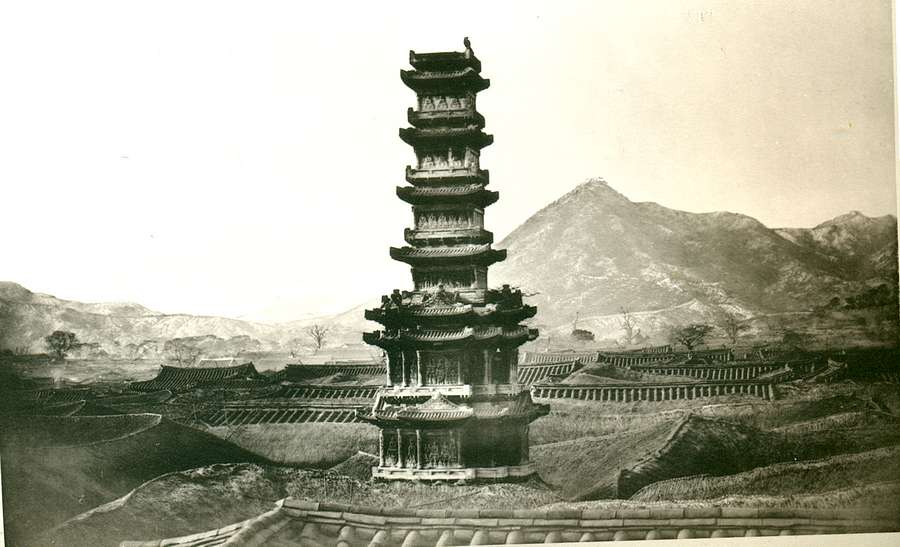
The Pagoda surrounded by houses, from Percival Lowell's "Choson:
The Land of the Morning Calm" (1886)

The site of Wongak-sa (now Tapgol Park) after the demolition of
the houses occupying the site by John McLeavy Brown in 1897
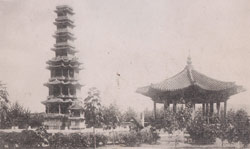
The pagoda in the 1920-30s with the topmost section standing
beside it

The Wongak Pagoda in Seoul's Tapgol Park before it was enclosed in
glass.

The inscribed stone recording the foundation of Wongak-sa
In 1915, the scholarly missionary James Scarth Gale published in the
Royal Asiatic Society Korea Branch's Transactions Vol. VI, part II:1-22 a very
important paper on “The Pagoda of Seoul.”
He seems to have been the first person in modern times to date
correctly the pagoda and explain its relationship with another
pagoda, which it resembles closely, the older Ten-Storied Pagoda of
Gyeongcheon-sa. He had been given an ancient rubbing of the
inscription on the by then illegible memorial stone (stele)
recording the establishment of Wongak-sa (temple) by King Sejo in
1465 and his paper includes a translation of that account.
The Ten-Storied
Pagoda of Gyeongcheon-sa
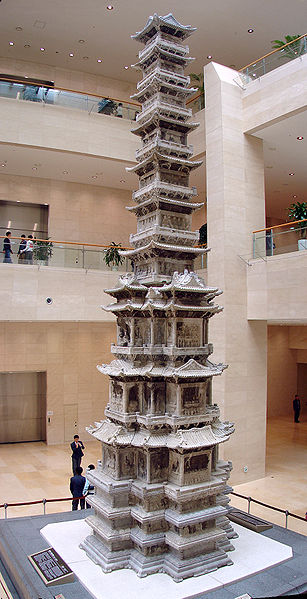
The Ten-Storied Pagoda of Gyeongcheon-sa in the National Museum of
Korea at present
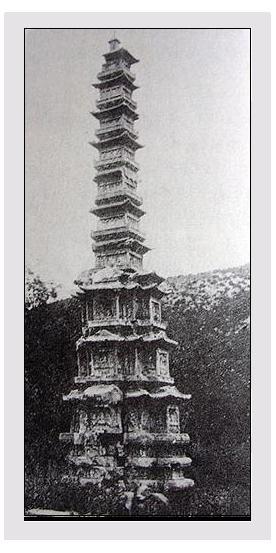
The Ten-Storied Pagoda of Gyeongcheon-sa in 1904
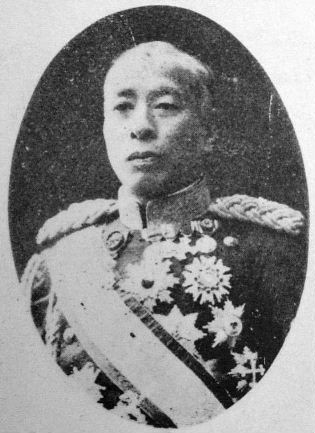
Tanaka Mitsuaki
Ernest T. Bethell
Ernest T. Bethell and Homer Hulbert come into the story because they
wrote newspaper articles to denounce the theft of the pagoda.
Ernest T. Bethell was born in England in 1872. Still a youth, he
went to work with his uncle in Japan in 1888. In 1904, at the start
of the Russo-Japanese War, he moved to Korea as correspondent for a
British newspaper. He denounced Japanese atrocities in his reports,
and since the paper’s policy was pro-Japanese, he was dismissed. He
remained in Korea, where he established the Korea Daily News and also
launched a Korean-language newspaper the Daehan Maeil Sinbo. These were both strongly
pro-Korean and anti-Japanese. The British government was favorable
to Japan, so Bethell was tried twice by a British consular court in
Seoul for sedition and violation of public order. First, he was
ordered to pay a 300-pound bond as a guarantee of his good behavior.
Yet he continued his attacks on the Japanese. On June 15, 1908 he
was sentenced to spend three weeks in the British gaol in Shanghai.
After serving his term, Bethell returned to Seoul and boldly resumed
publication of the Korea Daily
News. In April 1909 he fell victim to his heavy smoking and
drinking life-style, dying surrounded by friends on May 1. Hundreds
of Koreans accompanied his funeral. An anti-Japanese epitaph in
Korean was defaced soon after it was erected, then restored after
Liberation in 1945.
Bethell's grave in Seoul
The news of the theft of the Gyeongcheon-sa pagoda soon reached
Seoul. Bethell wrote about it in his newspapers. Homer Hulbert (then
in the US) made the facts known by articles in the Japan Chronicle, and then in
the New York Post and
from there the news spread across the globe. A rather garbled
account even reached a
newspaper in rural New Zealand. But nothing happened in the
following years, while Japan completed the annexation of Korea in
1910. The episode and its sequel is covered at some length in F. A.
McKenzie’s
Korea’s Fight for Freedom
(1920):
The organ of the Residency-General
in Seoul, the Seoul Press,
made the best excuse it could. "Viscount Tanaka," it said, "is a
conscientious official, liked and respected by those who know him,
whether foreign or Japanese, but he is an ardent virtuoso and
collector, and it appears that in this instance his collector's
eagerness got the better of his sober judgment and discretion."
But excuses, apologies, and regrets notwithstanding, the Pagoda
was not returned.
He was wrong. The pagoda had been returned to Seoul in 1918 but
having been damaged in its travels, it lay in pieces in
crates. Today the National Museum of Korea and other Korean
sources claim that this return was solely the direct result of
Bethell’s and Hulbert’s press campaigns. This might not, however,
really be the case. Ten years had passed, Bethell was dead, Hulbert
had left Korea for good long before. Why was it returned at that
time?
Sekino
Tadashi

Sekino Tadashi
Sekino Tadashi (1867-1935) was a professor in the Architecture
Department of Tokyo University. He was the first Japanese art
historian and architect sent to Korea in 1902, to serve as an
architectural historian and the main recorder of Korean antiquities.
Hyung Il Pai has described how ancient Korean remains were carefully
preserved, studied, recorded and registered as part of Japan's state
cultural properties as Kokuho (imperial treasures) as part of their
imperial cultural policy to incorporate the Korean peninsula, its
ancient history and its people as part of their ancestral homelands
(Nissen dosoron). Korea's ancient relics and remains were thus
reclaimed as "Proto-Japanese".
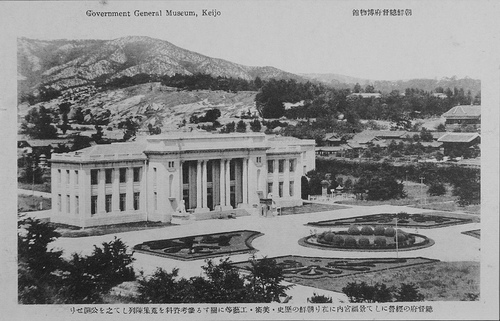
The newly built Art Gallery / Museum
In 1913, Sekino Tadashi began work on the first volume of the
"Chosen koseki zufu" (朝鮮古蹟圖譜) series (Album of ancient sites
and monuments), fifteen magnificent volumes of photos and drawings
of ancient Korean objects and sites published 1915-1935. This and
other publications by him were the origin of the present list of
Korean National Treasures. A
complete set of images of every volume can be seen here
(change the final number to view each volume 1 - 15)
Then the “Chosen Sotokufu (National Treasures) Museum” (aka the
Government-General Museum) was established in Gyeongbokkung in 1915.
The permanent museum was originally built as an art gallery on the
site of the demolished Jaseondang in the Donggung, the Crown
Prince’s Compound, as part of the Chosen Product Promotion
Exhibition held September 11 to October 31st, 1915 to
commemorate the fifth year of annexation. Then it became a museum
when the exhibition ended and in 1918 pagodas and sculptures from
abandoned palaces and temple ruins began to be exhibited in front of
this museum at the recommendation of Sekino Tadashi. That would best
explain why the Japanese brought the pagoda back. Another pagoda
brought back from Japan for similar reasons in 1915 can still be
seen in the grounds of Gyeongbok-gung behind the National Palace
Museum.
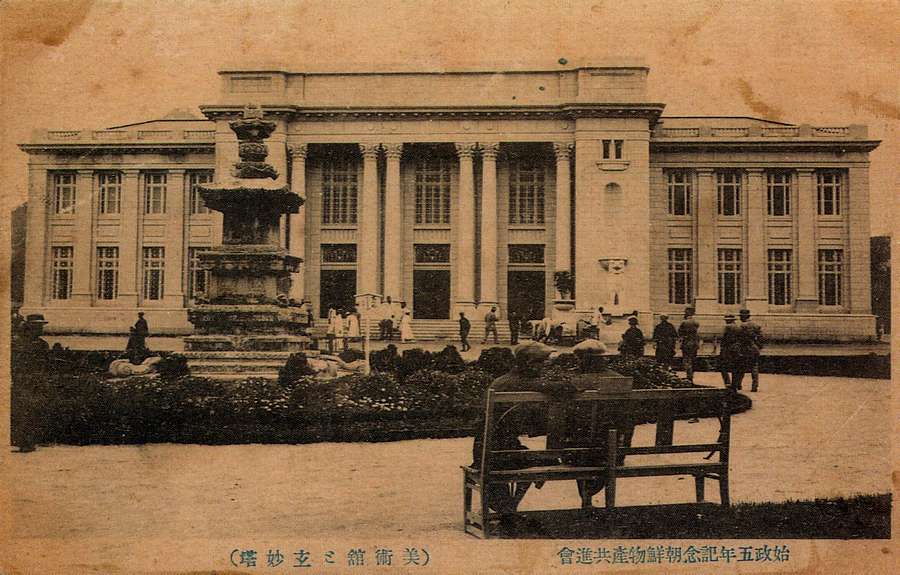
The Museum with an ancient relic in front of it
As noted above, James S. Gale wrote about the Wongak-sa Pagoda in a
paper that he presented at a meeting of the RASKB on February 5,
1915, published in Transactions
Volume VI, Part 2. He begins the paper by quoting words he
attributes to Sekino Tadashi:
“The pagoda stood originally within
the enclosure of Wun-gak Temple. It is precisely the same in
shape as the pagoda that stood on Poo-so Mountain in front of
Kyung-ch’un Temple, Poo’ng-tuk County, which dates from the close
of the Koryu Dynasty. Its design may be said to be the most
perfect attainment of the beautiful. Not a defect is there to be
found in it. As we examine the details more carefully, we find
that the originality displayed is very great, and that the
execution of the work has been done with the highest degree of
skill. It is a monument of the past well worth the seeing. This
pagoda may be said to be by far the most wonderful monument in
Korea. Scarcely anything in China itself can be said to compare
with it. The date of its erection and its age make no difference
to the value and excellence of it.”
In his paper, Gale establishes that the Wongak-sa Pagoda was made in
imitation of the Gyeongcheon-sa pagoda, and erected in 1466. Sekino
Tadashi’s words (no source for them is indicated) apply equally to
both the original Gyeongcheon-sa pagoda, which he has obviously
seen, and the later copy. If Sekino Tadashi wrote like that about
the Gyeongcheon-sa pagoda, surely he would have done everything
possible to bring it back from Japan to house in the new museum? It
duly returned to Korea from Japan in 1918, to be housed in the new
museum, and there it remained, damaged and in fragments, until it
was restored and re-erected in the garden in front of it in 1960.
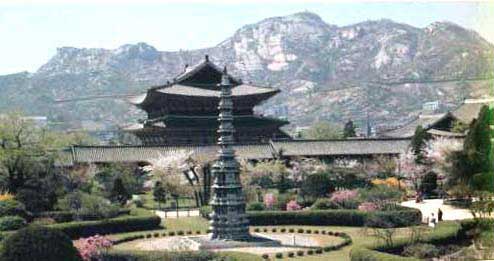
The Gyeongcheon-sa pagoda was erected in Gyeongbok-gung gardens in
1960
Damaged by acid rain, it was removed and today it is safely housed
inside the National Museum. There, rather than admit that the
Japanese Sekino Tadashi arranged for its return, the plaque before
it gives all the credit to the campaigns of Bethell and Hulbert more
than ten years before. It is significant that Gale notes twice in
his paper about the Wongak-sa Pagoda that the Gyeongcheon-sa pagoda
had been taken to Japan a few years before. He nowhere indicates
that he regrets that fact, or that he hopes for its return. There
was clearly no continuing campaign for its return alive in Korea in
1915.








